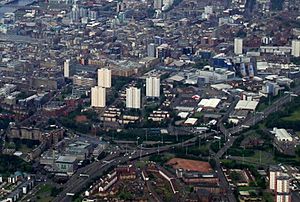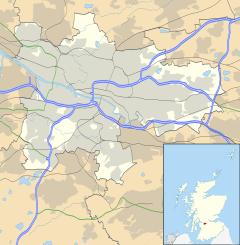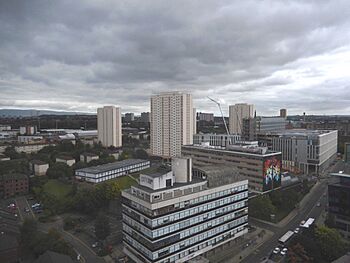Townhead facts for kids
Quick facts for kids Townhead
|
|
|---|---|
 Aerial image looking east over Townhead area (2012) |
|
| OS grid reference | NS595658 |
| Council area | |
| Lieutenancy area |
|
| Country | Scotland |
| Sovereign state | United Kingdom |
| Post town | GLASGOW |
| Postcode district | G1 |
| Dialling code | 0141 |
| Police | Strathclyde |
| Fire | Strathclyde |
| Ambulance | Scottish |
| EU Parliament | Scotland |
| UK Parliament |
|
| Scottish Parliament | |
Townhead (Scottish Gaelic: Ceann a' Bhaile, Scots: Tounheid) is a historic area in the city of Glasgow, Scotland. It is one of Glasgow's oldest parts and is home to two important medieval buildings: Glasgow Cathedral and the Provand's Lordship.
In the past, Townhead was the main way to enter Glasgow from the north. Today, it is at the north-eastern edge of the city centre. Townhead changed a lot between the 1950s and 1970s. Many people moved out, and new buildings were put up. Now, fewer people live there, but it has businesses, factories, and a big education area. This area includes parts of the University of Strathclyde and City of Glasgow College.
Contents
Where is Townhead Located?
Long ago, Townhead was an open area north of the cathedral. It did not have clear borders. Today, it has specific neighbours. To the west is Cowcaddens, and to the north is Sighthill. To the east are Royston and Ladywell/Dennistoun. To the south is the Merchant City.
Townhead's main borders are:
- North Hanover Street and Dobbie's Loan to the west.
- The M8 motorway to the north.
- Castle Street and High Street to the east.
- George Street to the south.
Homes in Townhead
Most homes in Townhead used to belong to the city council. Now, they are managed by the Glasgow Housing Association. The area also has many places for students to live. These include students from International Christian College, Glasgow Caledonian University, and Strathclyde University.
Most houses are modern flats, often built in groups of eight. The most noticeable buildings are four tall 24-storey blocks. These are called "2 Taylor Place," "15 Grafton Place," "7 St Mungo's Place," and "12 Dobbies Loan Place."
Townhead's Story: A Look Back in Time
Early History: From the 15th Century to the 20th Century
Many believe that St Mungo, also known as St Kentigern, built his church near modern-day Townhead. He built it by the Molendinar Burn, which helped start Glasgow. Glasgow Cathedral, named after St Mungo, stands roughly where his first church was. The current cathedral building is from the 12th century. Today, the Cathedral is just outside Townhead, in the Ladywell area.
Provand's Lordship is Glasgow's oldest house still standing. It was built in the late 1400s by Bishop Andrew. It was part of St Nicholas Hospital, which helped poor people. The hospital offered a place to stay and care for twelve poor men. They worked there, studied the Bible, and grew plants in the gardens. The gardens were fixed up in 1997. Like the original St Nicholas garden, they grow plants known for healing.
The Covenanters, a group of Scottish Presbyterians, were executed in the area now called Townhead. The northern part of Castle Street was the edge of the town. Beyond it was an area called "Howgait." Howgait was where public hangings happened until 1781. Today, this area is mostly covered by Junction 15 of the M8 motorway.
The former Martyrs' Church building used to hold the Martyrs stone. This stone tells about the executions of James Nisbet, James Lawson, and Alex Wood in 1684. The stone was moved in 2013. It can now be found in the wall of "The Evangelical Church" near Cathedral Square.
The Church of Scotland still supports Townhead through Glasgow Cathedral. It also helps the SIMY Community Development charity. SIMY is a local group run by volunteers. It helps young people with youth work, arts, sports, and life skills. It also offers outdoor education and clubs.
The Church of Scotland is looking to sell the land where the Martyrs' Church used to be. There are plans to build homes and a community building there.
St Mungo's Church on Parson Street was built in 1869. It has an Italian-Gothic style. The famous architect Charles Rennie MacIntosh was born at 70 Parson Street. He also helped design Martyr's School at 17 Parson Street.
Modern Townhead: Changes and New Buildings
After World War II, Glasgow started to change many of its older areas. Townhead was one of these places. It was chosen for a "Comprehensive Development Area" plan. This meant that many old tenement buildings were knocked down. The people living there were moved to new homes.
Townhead's main old road, Parliamentary Road, was destroyed. Most of the old street plan was also removed. New homes were built, including lower buildings and four tall 24-storey tower blocks. Some Townhead residents moved into these new buildings. Others moved to new housing areas on the edge of the city. Because of this, almost all the old tenements in Townhead are gone. However, some new buildings and paths keep the old street names.
North of Parliamentary Road, the cleared land became a new industrial area. This area had new factories and stretched towards Baird Street. The new Glasgow Inner Ring Road acted as its border.
The southern part of Townhead, between Parliamentary Road and George Street, was cleared for a new education area. Several new colleges were built here. The main part of this area became the new University of Strathclyde. This university grew from the old Royal College of Science and Technology.
One of Townhead's most famous and oldest streets, Rottenrow, is in this area. From this high point, St Mungo could see the River Clyde and spot any approaching enemies. Rottenrow was also home to the Glasgow Royal Maternity Hospital. This hospital was taken down in 2001 and replaced by a garden.
In 1972, a publishing company called William Collins, Sons sold its printing works to the University of Strathclyde. This was once a very large industrial complex in Townhead. The land and buildings were then used for university purposes. For example, a huge warehouse became the new home for the Andersonian Library in 1980.
The New Barony Church was bought by the University of Strathclyde in 1986. It was fixed up in 1989 and is now a special hall for events called the Barony Hall.
In the 2010s, the new City of Glasgow College was created. It was formed by joining several other colleges. A new "supercampus" was built on Cathedral Street and opened in 2014. The University of Strathclyde also built a new sports centre nearby in the same year.
Artistic Connections
The artist Joan Eardley lived and worked in Townhead from 1950 to 1957. She was very interested in painting the children of the area.
Recent Changes in Townhead
Townhead has a community council made up of local volunteers. Recently, Townhead joined with the Ladywell area for community council purposes. This created the Townhead and Ladywell Community Council. This group helped get money to build a village hall in Townhead, which opened in 2013.
The community council has also raised concerns about new student housing. They worry about how close these new buildings are to homes. They also want to make sure new building projects do not cause too much trouble for local people. Townhead has seen many applications to turn regular homes into Houses of Multiple occupation (bedsits). The community council has spoken up about these concerns.
The sale of the Glasgow Cathedral Martyrs church building meant the community lost a key meeting place. This area is also set to get more student housing.
SIMY Community Development is a large local charity run by volunteers. They work with the community council to create new activities for young people in Townhead. They sometimes take young people to other areas because Townhead no longer has indoor sports places. The demolition of the Martyrs church will be the third large community building removed from the area since 2012. It will also remove the only indoor sports courts still available to the public.
The Martyrs stone was moved on September 12, 2013. It was moved by Glasgow City Council to the Glasgow Evangelical Church in Cathedral Square. This is a historic part of Glasgow where many people can see it.
The Townhead Village Hall opened in 2013. It offers social activities and services for the community. The building is owned by a company led by the community. Since St Mungos School no longer allows community lets, the Village Hall is now the only place for community activities. The hall is used every day and evening. In November 2013, the village hall opened its Townhead Orchard. This is a green space where local people can enjoy gardening.
In 2013, Townhead's role as a major education area grew. More student housing was planned to match the new large college campus. This is part of the council's plan for the area.
Getting Around: Transport Links
Townhead is very well connected for transport. Glasgow Queen Street Station and Buchanan bus station are very close by.




